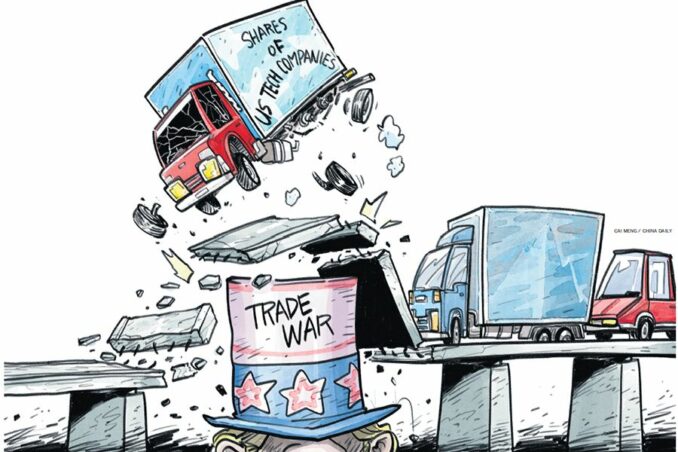Tariffs, the U.S. and China
On May 10, 2019, then President Donald Trump imposed a 25% tariff on $200 billion worth of goods imported from China. Workers World’s editorial four days later noted that the tariff had little permanent impact on the Shanghai composite stock index.

Credit: China Daily
When China carefully retaliated with tariffs ranging up to 25% on $60 billion worth of U.S. goods, however, three days later the U.S. stock market plunged 617 points.
Trump then imposed an additional 10% tariff on $300 billion of Chinese imports on Aug. 1, 2019. The Chinese Commerce Ministry then announced it would halt imports of all U.S. agricultural goods. At that time China was U.S. agriculture’s largest export market.
WW noted that the fallout from the tariff battle revealed which of the world’s two largest economies was more fragile and unstable. Today, the latest round of tariff wars between the U.S. and People’s China continues to expose the instability of the profit-driven imperialist U.S. and the relative stability of China’s planned economy.
While candidate Joe Biden vowed to remove Trump’s tariffs, President Joe Biden kept most in place. Now Biden is promoting a new U.S. tariff war against China. In August he announced a whopping 100% increase in U.S. tariffs on the import of Chinese electric vehicles (EVs), 50% on solar cells and 25% on electric vehicle batteries, critical minerals, steel, aluminum, face masks and ship-to-shore cranes beginning Sept. 27.
U.S. crony imperialist allies in Canada and the European Union quickly followed suit with announcements of similar tariffs on China’s electric vehicles.
China quickly responded with a range of countermeasures, including its own tariffs on U.S.-produced EVs. Beijing filed an anti-discrimination dispute against the European Unionn tariffs with the World Trade Organization. A similar measure against Canada is in the works.
Advantage of planned economy
The tariff war focused on EVs highlights an essential difference between production under capitalism and under a planned economy. In the U.S. and other capitalist countries, most production is under private ownership and most profits go to owners, including shareholders and individual billionaire capitalists, like Elon Musk who controls a majority ownership of the company that produced the most EVs in the U.S. in 2023, Tesla.
Prices for EVs in the U.S. are often out of reach for most consumers, and there is no planned process for expanding the availability of EV charging stations.
In China, the state, managed by the Chinese Communist Party, sets production goals. The Chinese conglomerate BVD, which produces most EVs, is not state controlled. It has, however, received state subsidies as part of China’s long-term plan to reduce carbon emissions.
From 2009 to 2023, the Chinese government provided $230.9 billion in a combination of state support that included buyer rebates, sales tax exemptions, construction of charging stations and research and development support for the industry.
BVD now produces 70% of the world’s electric cars, which are sold for as little as $10,000. The quality of EVs that BVD produces now makes them highly competitive, and the company is seeking to expand markets globally. (tinyurl.com/2tx63ud5)
In comparison, over the same 14-year period the U.S. combined military/defense budget was over $10 trillion. This budget subsidizes the U.S.-based military-industrial complex, and the U.S. sells enormous amounts of weapons worldwide. The U.S. military, while waging wars globally, is the single largest entity contributing to global warming.
Weapon of war or boost for economic development?
Tariffs are tax revenue collected from domestic consumers of imported goods. Governments impose tariffs to limit sales of imports, which might benefit selected home-based corporations. They are an economic weapon that in past centuries have often led to military conflicts among imperialist competitors.
China has demonstrated that by elimination of tariffs imposed on goods from developing countries both trade and development can be increased. In early September at the opening of the Forum on China-Africa Cooperation (FOCAC) summit in Beijing, China’s President Xi Jinping announced that China would unilaterally give all of the least developing countries that trade with China, including 33 in Africa, zero-tariff market access for all products. The agreement includes over $50 billion of investments by China in African development initiatives over the next three years. (tinyurl.com/3ya62y9k)
The new trade measure will greatly facilitate trade between Africa and the world’s second-largest economy. It will also provide new impetus for Africa’s development through accentuating trade and investment.
Song Wei, a professor at the School of International Relations and Diplomacy at Beijing Foreign Studies University, told the Global Times, Sept. 5: “The core development concept is to unlock Africa’s autonomous development capabilities through enhanced trade, rather than merely increasing the volume and quality of China-Africa trade.”
China is helping Africa to break out of an underdevelopment that was forced on it by Western colonialism and imperialism.
The U.S. and other imperialist states — with economies fueled by their drive for profits and exploitation of workers — find large sectors of their economies unable to sell quality goods at competitive prices compared with socialist China. The U.S. and its allies have turned to tariffs as a weapon of economic warfare. And the tariffs are weapons that hit the consumers, that is, the workers at home who will pay the price of the tariffs.
The question is not only which economy — the decaying imperialist economy of the U.S. or the developing, planned socialist economy of China — will come out stronger in the end, but will the imperialists turn to war when tariffs fail to solve the problems caused by capitalism?

